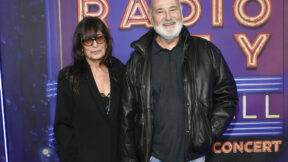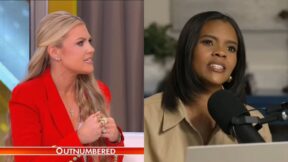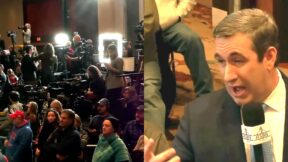Exclusive: Janice Min on The Ankler, Major Upheavals in Hollywood, And The Future of the Media Business
Janice Min, the veteran news editor and executive credited with reviving The Hollywood Reporter, a few years ago launched a different kind of media venture: The Ankler, a subscription-based news outlet covering Hollywood and the entertainment business.
The Ankler started off as popular Substack newsletter written by journalist Richard Rushfield that boasted a fleet of big name readers (David Zaslav and Richard Plepler are avid fans). In the last few years, Min and Rushfield have grown the business into a network of newsletters and podcasts devoured by entertainment industry insiders.
Min joined Mediaite’s The Interview podcast this week to discuss how she built The Ankler, her incredible career in journalism, the future of the media business, and a rocky year for Hollywood.
Watch the full interview above, and read highlights from the discussion below.
On The Ankler
The idea behind The Ankler is to give this very engaged, professional, high end entertainment audience news it is not getting anywhere else. It’s a high-level analysis and data and information. How it all started was Richard Rushfield, who is a very well-known writer in Hollywood, broke off and started his own Substack, like so many people did but he was probably one of the first. And I had in my world all these very senior people, CEO level, top producers, top attorneys were telling me, ‘Have you seen this thing that this guy Richard Rushfield is doing?’ And so I became a subscriber and loved it.
What Richard was doing was really capturing the the shifts in entertainment that we were seeing, that we started to see back in 2019 where it was going from a legacy, old studio business with seven studios into a streaming-led economy, and it was turning everything upside down, both in the kinds of shows and movies that were getting made, but also in the employment of people in town and the town’s hierarchical structure. Richard was owning that disruption.
I asked him if he wanted to do something more with it. And we did a small fundraiser. We were in Y Combinator, and we managed to make a business out of it. One of the things I’m proudest of is that what we do at The Ankler is very thoughtful. I would like to think it’s some of the smartest things you can read about the entertainment business in town. And it’s a high subscription price. It’s $149. And what we’re not doing is trading on news as a commodity. I am always pleased to see the stories that perform best for us are the ones that we’re giving people information they are not finding anywhere else.
On the trade magazines
Well, I think that everything has its era. You saw in the entertainment space, Nikki Finke in Deadline, we had that era and it really disrupted the way trades did things. The Hollywood Reporter came in and really went from the last place loser to the dominant publication in the entertainment space. I would say that competition was always a big part of making the trade press. And certainly in that decade, when I worked at The Hollywood Reporter, it was a vital part of motivating the newsroom to differentiate content.
So when Jay Penske took ownership of the major trades of both Hollywood Reporter and Variety and then also Deadline, I think that was tough. I think it obviously reduces competition, but I also think it’s a dilution of voice, and there was also this marketplace for journalists where many times I had to counter someone’s salary because they were getting offered a job at Variety or Deadline. At that time everyone wanted this magic of The Hollywood Reporter on their staff. People felt like they had options in town and in Los Angeles.
Now, you’ve really limited your options because there’s one place that’s probably the largest employer in terms of entertainment media, but probably all media. So I don’t think that’s great. I also think that when you work at one of those big trades, there’s so many competing interests that dilute the journalism of it. And because you have events, you need to book people, you need to book people for the covers. You have major advertisers who are going to freak out about this and that. So I’ve been really proud of the way at The Ankler that we’ve been able to break stories and do stories with our tiny little, now six-person staff that the trades don’t get with their hundreds and hundreds of people.
On Hollywood’s year of strikes
There was a monumental shift in Hollywood and a major mood change because of the Hollywood strikes. There are lasting ripple effects. It’s like a family who had a massive fight. I don’t know if anyone saw the Christmas episode of The Bear, but it’s a little bit like this, like a dysfunctional family now coming back together.
And what really struck me about the strikes was how virulent some of the comments were from top people on the creative side, from the writers and the actors. And certainly you saw Fran Drescher doing that work. In the years before, even the months before there was a certain reverence around the CEOs, around Bob Iger, around David Zaslav and this sort of mogul worship.
These were like the great men of entertainment and that got blown apart with the strikes where there were sort of this — and I would apply this to any place where Silicon Valley or venture money or private equity money has taken hold or even, you know, this whole notion of earnings reports that became the guiding drumbeat of Hollywood and that did not exist even just a few years ago. And so what the strikes revealed was this resentment by the workers — and when I say workers, I’m talking about even showrunners who have hundred million dollar deals at studios — of just how the playing field changed and the resentment towards not sharing the wealth, the amount that CEOs are getting paid, they’re paying themselves when they’re cutting back on programing spending and on people’s pay and salaries.
So that really brought to the forefront this resentment that you’re seeing in every industry that has been upended by both Wall Street and finance, but also Silicon Valley. And I think Richard Rushfield, my partner at The Ankler, writes about this a lot. But, you know, one of the Silicon Valley tenets is how to constantly decrease the cost of labor to keep making more money and that’s how you scale and also the replaceability of labor, eventually the replaceability of humans. There was a brokenness that was revealed in the strikes that brought that conversation forward.
Subscribe to The Interview on YouTube, Apple Podcasts, or Spotify.




